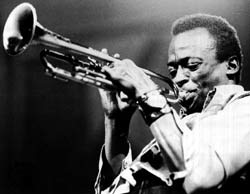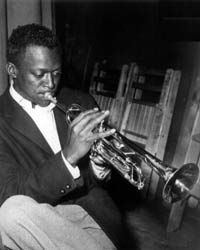Life Issues – Miles Davis

Miles Davis is one of the most famous artists of all time. Although he is known principally for his performances as a jazz trumpet player, Davis was a bit of a polymath, delving into keyboard and organ music, and even classical music studies.
Davis claimed that he was haunted by music, that he was cursed to be able to think of nothing but music for as long as he was awake. However, he was clearly able to multitask, as he was quite a talented abstract painter. No doubt he whistled a jaunty tune whilst the brush moved between the palette and canvas.
The Life of Miles
Miles Davis was born on May 26, 1926. He grew up in East St. Louis, Illinois, which, as the name suggests, is east of St. Louis (Missouri), on the other side of the Mississippi River.
Miles’ father gave him his first trumpet when Miles was 11 years old. From the moment the brass touched his lips, Miles dedicated himself to mastering the instrument. By the time he reached high school, Miles was a brilliant musician, and the star of the school band.
As travel by air was not commercially available in his childhood, the Mississippi River was a principal source of transportation, bringing people north along the river, all the way from New Orleans, Louisiana, deep in the heart of the South. These riverboats often employed great jazz musicians to entertain their passengers. When the boats would dock in St. Louis, Miles would travel across the river to meet the musicians, and listen to them perform.
In this fashion, Miles met many jazz greats while he was still quite young. After he had graduated from high school, a meeting with Charlie Parker and Dizzy Gillespie prompted Miles to move to New York City and become a jazz musician.
Miles had come from a relatively wealthy family with a supporting father. So, rather than moving to the big apple to become a starving artist, Miles enrolled at the Juilliard School of Music, one of the finest music conservatories in the world. Thus, much like jazz itself, Miles’ musical style was borne of a concert of opposition. He studied strict classical music in the day, and spent his nights playing jazz at clubs. Rather than favouring one style, Miles combined classical music and jazz in his own music, creating a dynamic tension that added stylistic density to his work. Although he withdrew from Juilliard in 1946 to devote himself full-time to jazz, Miles Davis maintained that his classical training helped him to better understand music and made him a better musician.
Playing in Charlie Parker’s quintet from 1946 to 1948 forced Miles to learn to play at breakneck speeds with manic chord substitutions. However, despite his keen ability to play in Parker’s style, the music in Miles’ head moved at a slower pace. Thus, when he joined a 9 piece band, of which he soon became the de facto leader, Miles began playing music that was a bit less tepid and volatile. This led to the creation of the album “Birth of the Cool,” which, despite the record company’s unwillingness to release the LP for nearly a decade, skyrocketed Miles Davis to stardom.
He was seen not just as a musician, but as a cultural icon, a statuesque representation of “cool” detachment; a man who dressed in the sharpest clothing, dated the hottest women, and drove the fastest cars. He was the man that everyone tried to be.

A World in Black and White
Talent and Fame did not alleviate racial tensions, however.
When Davis had been attending Juilliard, he was put off by a teacher’s comments that African Americans played the blues because they were poor and had to pick cotton. Miles respectfully informed her that he played the blues, despite the facts that he grew up wealthy, and never picked cotton (he neglected to inform her that he was African American).
In the height of his popularity, while performing at a club in New York, Miles strolled outside with a friend of his, the newspaper columnist Dorothy Kilgallen, who happened to be a white woman. A police officer (who happened to be a white male in case you’re keeping track) saw the pair and, enraged to see a black man with a white woman, hit Miles in the head with a nightstick, and took him, bleeding, to jail. Miles sued the city of New York, but lost the case over a technicality.
Musical Style and Innovation
Despite his fame, Miles Davis ignored propriety and did not care how he was seen. He began performing with his back turned to the audience, a move that many people misinterpreted as a sign of vanity and arrogance. From Miles’ perspective, however, it was a question of musicianship. He was facing his band because it was a necessary means to communication between artists. Though he held a trumpet to his lips, he was performing the same role as an orchestra’s conductor.
In the 1950s, Miles created a new quintet, in which he performed alongside John Coltrane. With this quintet, he released many essential albums, including “Cookin’,” Steamin’,” “Workin’,” and “Relaxin’.”
Never one to settle on a certain style, Miles Davis experimented with every form of music he encountered. By the 1970s, he saw that rock was the newest musical challenge. He began to delve into electric music—electric guitar, electric bass, rows of electric keyboards, and even his own trumpet, amplified. The dark, experimental album, “Bitches Brew” was the result; and the highest selling jazz album of all time.
As he began experimenting in minimalist electronic music, Miles Davis anticipated the direction of electronica and techno first popularized in the 1980s. But he did not stop there, and even went on to record a collaboration with some rap artists, which, despite his death mid-recording in 1991, was released in 1992 in the album “Doo Bop.”
By the time of his death, Miles Davis had released over 100 albums, and had taught the world a thing or two about music.
Join us soon for another Life Issues.

